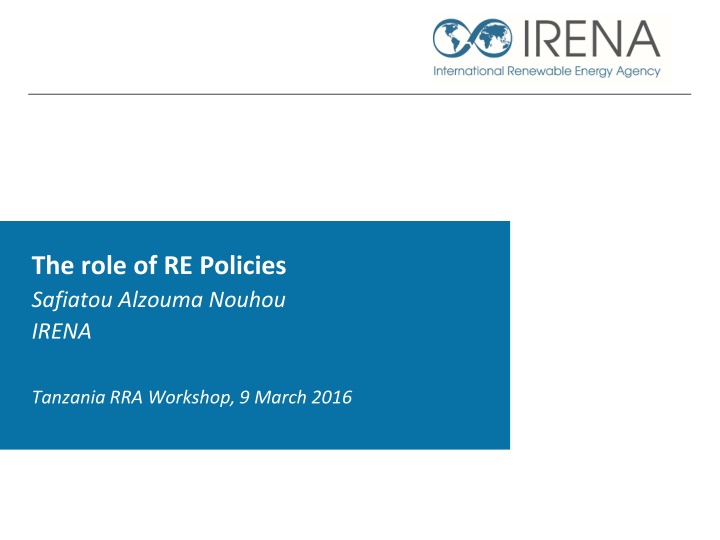The role of RE Policies
Renewable energy policies are crucial for driving deployment, with key elements including government commitment, smart remuneration arrangements, stability, and actions to tackle barriers. Factors influencing policy choice include sector maturity, flexibility, price discovery, certainty, and market segment considerations. Policies are expected to support project development by ensuring cash flow certainty, reducing uncertainties, standardizing procedures, and de-risking transactions. Feed-in tariffs are a commonly used policy instrument for supporting renewable energy development.
Download Presentation

Please find below an Image/Link to download the presentation.
The content on the website is provided AS IS for your information and personal use only. It may not be sold, licensed, or shared on other websites without obtaining consent from the author.If you encounter any issues during the download, it is possible that the publisher has removed the file from their server.
You are allowed to download the files provided on this website for personal or commercial use, subject to the condition that they are used lawfully. All files are the property of their respective owners.
The content on the website is provided AS IS for your information and personal use only. It may not be sold, licensed, or shared on other websites without obtaining consent from the author.
E N D
Presentation Transcript
The role of RE Policies Safiatou Alzouma Nouhou IRENA Tanzania RRA Workshop, 9 March 2016
Foundations of a policy framework Renewable energy policies remain the most important driver of deployment. While the choice of policy varies depending on specific market conditions, an enabling policy framework should cover at least the following key elements: Long-term government commitment, and credible short, medium and long term targets. Smart remuneration arrangements which recognize the capital intensive nature of the renewables by providing long term predictable revenue streams. Overall stability and predictability, with built in flexibility to allow adaptation. Actions to tackle non-economic barriers including streamlining planning and permitting, developing the necessary skills base and providing public information. 2
Trends in policy Number of countries with renewable energy policies, by type Rise in the adoption of auction (or tendering) schemes to mostly support large-scale renewable energy development 3
Factors influencing choice of policy instruments A number of factors influence the choice of policy instruments: Maturity of power sector: Current mechanism of capacity procurement, availability of IPPs, state of financing for energy sector. Flexibility: Giving governments the flexibility to incorporate learning by doing and adapt policies, regulations, processes and/or targets. Price discovery: Closely tracking decreasing cost of deployment to maximise efficiency and effectiveness of support. Greater certainty regarding price and quantity: Aligning deployment with financial resource availability and infrastructure development. Market segment: Scale of deployment ranging from small-scale off-grid to roof-top and utility-size development. 4
Expectations from policies in supporting project development kWh kWh Off-taker/Buyer Generator End-user $$ $$ $$$ $$ Renewable energy policies are required to: Financier Ensure long-term certainty in cash-flows for the generators Reduce uncertainties and transaction costs Standardize procedures Increase participation of IPPs (where possible) Support the building of a track record of projects to attract more financing De-risk electricity or financial transactions (e.g. b/w off-taker and generator or financier and generator) 5
Feed-in tariffs Most widely used policy instrument to support the development of renewable energy. Provides maximum levels of certainty in terms of project revenues from electricity generation. Reduces usually transaction costs and administrative processes given that tariffs are fixed. Drove deployment in earlyadopter countries such as Germany, Italy, Spain and the United Kingdom. Regulatory Policies Early challenges associated with unregulated deployment, limited cost tracking leading to over compensation, financial cost and market integration of high shares of renewables. Auctions/Ten dering Feed-in tariff Several adaptation measures introduced such as automatic degression schemes and caps on volume and costs. 6
Feed-in tariffs in Tanzania 100kW - 10MW threshold for FiT (hydro and biomass only) Guarantee up to 25years 7
Auctions/Tendering Auctions have increasingly been adopted to support renewable energy deployment Number of countries that have adopted Renewable Energy Auctions 70 60 50 40 30 20 10 0 2005 2006 2007 2008 2009 2010 2011 2012 2013 2014 2015 Based on REN21 Global Status Report (2005 to 2015) 8 2014 2015 2013
Auctions/Tendering Strengths and weaknesses of Auctions Flexibility Real price discovery Strengths Greater certainty regarding prices and quantities Commitments and transparency Relatively high transaction costs Weaknesses Risk of underbuilding and delays
Auctions/Tendering Design elements
Policy and regulatory frameworks for off-grid RE Integrating off-grid RE into the national rural electrification strategy supported by dedicated policies relevant to the sector Stable policy frameworks Several rural electrification programmes have succeeded after years of learning and course correction Policies need to as dynamic as the market they set out to support Effective sector regulation Encouraging innovation in technology design, financing and business models that reduce costs and improve efficiency Flexible tariff-setting for mini-grid projects to allow commercial viability Cooperation and coordination Between national and international (public, financing, research, etc.) institutions involved in rural electrification Between different sectors (health, agriculture, etc.)
An Integrated Policy Framework Research and innovation Education and training Strengthening firm-level capabilities Deployment policies Local content requirements Investment promotion and technology transfer 13
Key policy recommendations Tailored policy mix adapted to country conditions and market segments (large-scale, small-scale and off-grid) Long-term strategy with clear targets Stable, predictable and adaptable policy framework Forward-looking skills, education and training policies Higher degree of institutional development and coordination























